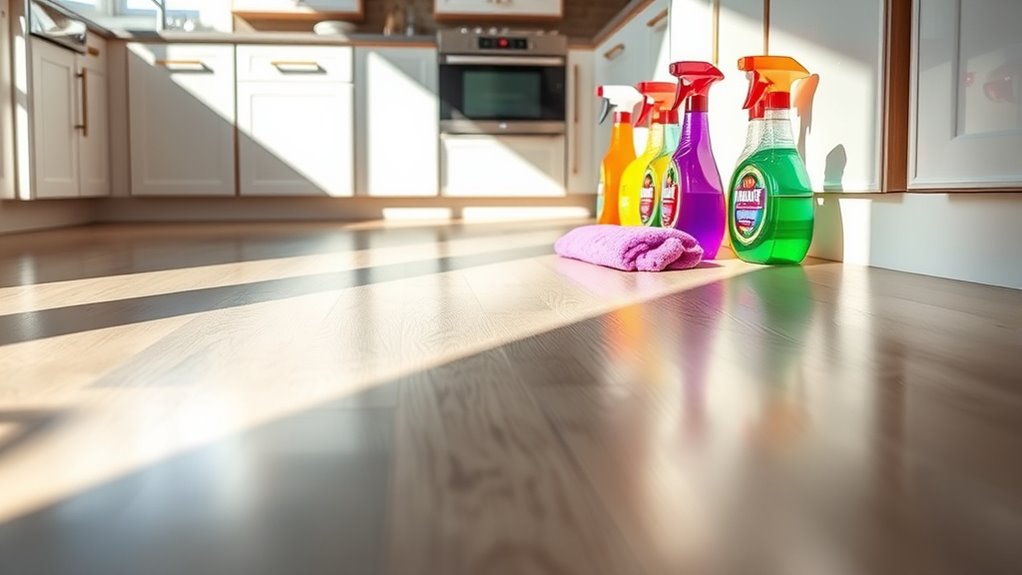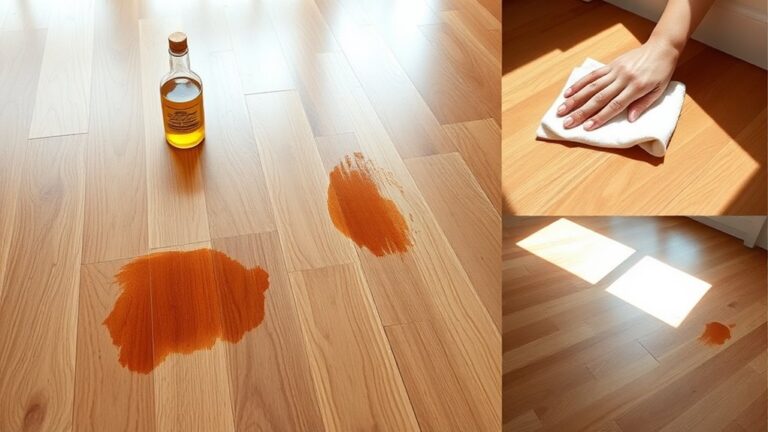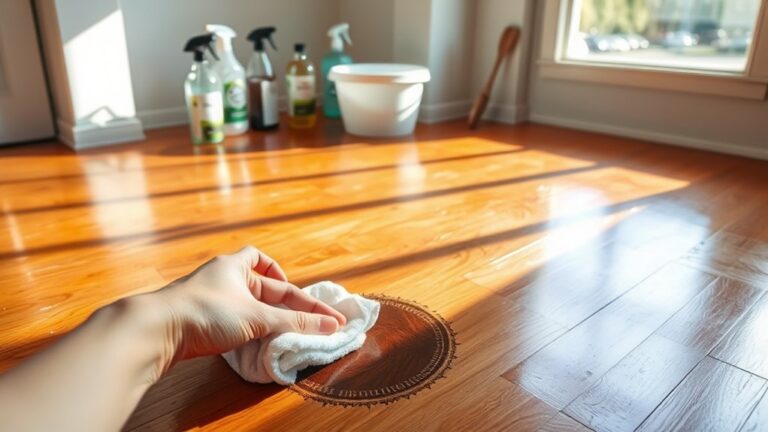To choose the best laminate floor cleaner, pick one with pH-balanced, non-toxic ingredients that won’t damage your floor’s finish or leave residue. Avoid harsh chemicals like ammonia, bleach, or wax-based products that can cause warping or dullness. Opt for a product designed to clean gently without excess moisture, ideally used with a damp microfiber mop. Using the right cleaner and method protects your floor’s durability, and there’s more to learn about effective cleaning and maintenance techniques.
Understanding Laminate Flooring and Its Cleaning Needs
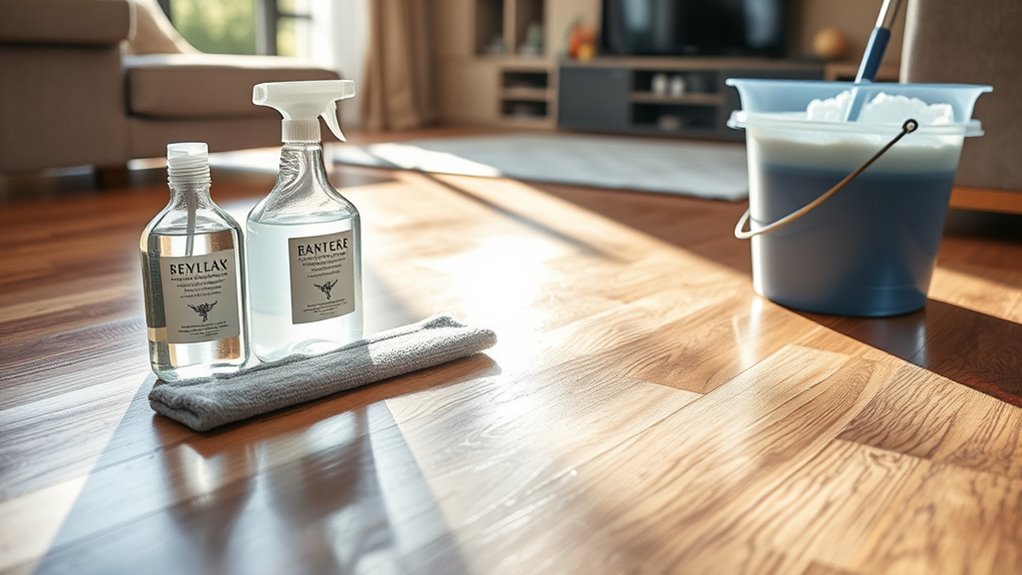
Although laminate sol is designed to be durable and easy to maintain, you need to understand its specific cleaning requirements to keep it looking its best. You’ll appreciate the laminate flooring benefits—like resistance to scratches and stains—thanks to its wear layer, which enhances laminate flooring durability. But this doesn’t mean you can use any cleaner or method. Excess water can seep into the seams and cause swelling or warping, so avoiding soaking your floors is essential. You should stick to gentle, pH-neutral cleaners designed for laminate surfaces. Regular sweeping or vacuuming without a beater bar prevents dirt buildup that can dull the finish. Knowing these details helps you preserve your floor’s appearance and freedom to enjoy a low-maintenance, long-lasting solution.
Key Ingredients to Look for in Laminate Floor Cleaners
When choosing a laminate floor cleaner, you’ll want to focus on non-toxic cleaning agents that are safe for both your family and the environment. Look for anti-streak formulas that leave your floors spotless without residue or dulling. Additionally, pH-balanced ingredients are essential to protect the laminate’s surface and maintain its finish over time.
Non-Toxic Cleaning Agents
What should you look for in a laminate floor cleaner to guarantee it’s both effective and safe? Prioritize non-toxic cleaning agents that protect your health and the environment. Here’s what to focus on:
- Plant-based surfactants – These eco friendly options break down dirt without harsh chemicals, ensuring safe ingredients for your home.
- Biodegradable solvents – They dissolve grime effectively while minimizing environmental impact, aligning with your freedom to choose green products.
- Natural preservatives – Ingredients like citric acid prevent microbial growth without toxic additives, keeping your floors clean and your air pure.
Choosing cleaners with these non-toxic agents means you maintain spotless laminate floors without compromising safety or sustainability.
Anti-Streak Formulas
Two key ingredients you should look for in anti-streak laminate floor cleaners are polymers and alcohol-based solvents. Polymers create a thin, protective layer that prevents streaks, while alcohol-based solvents evaporate quickly, reducing residue. When comparing formulas, focus on these ingredients for superior anti streak effectiveness.
| Ingredient | Role in Anti-Streak Formula |
|---|---|
| Polymers | Forms protective, streak-free film |
| Alcohol-based Solvents | Quick evaporation, reduces residue |
| Surfactants | Breaks down grime without haze |
| Anti-static Agents | Prevents dust attraction |
| Emollients | Adds shine without stickiness |
Understanding formula comparisons helps you pick a cleaner that guarantees freedom from streaks and a flawless finish every time you clean.
Ph-Balanced Ingredients
Since laminate floors can be sensitive to harsh chemicals, choosing a pH-balanced cleaner is crucial to maintain their integrity and appearance. The pH scale ranges from 0 (acidic) to 14 (alkaline), and laminate floors require cleaners around neutral pH (6-8) to avoid damage. When picking a cleaner, focus on these balanced solutions:
- Mild surfactants – effectively lift dirt without stripping the floor’s protective layer.
- Neutralizing agents – stabilize the formula to prevent acidic or alkaline extremes.
- Water-based solvents – guarantee the cleaner is gentle and won’t warp or discolor your flooring.
Ingredients and Chemicals to Avoid for Laminate Floors
You’ll want to avoid cleaners with harsh chemicals like ammonia, bleach, or wax, as they can damage your laminate’s protective layer. Instead, opt for safe natural alternatives such as vinegar diluted with water or gentle plant-based solutions. These ingredients effectively clean without compromising your floor’s finish or durability.
Harsh Chemicals to Skip
Although laminate floors are durable, certain chemicals can damage their surface or dull their finish. To avoid cleaning damage, steer clear of these harsh chemicals:
- Ammonia and bleach – These strong agents can strip the protective layer, leaving your floor vulnerable to scratches and fading.
- Abrasive cleaners – Powders and scrubbing pads may cause micro-scratches that dull the floor’s shine over time.
- Wax or polish-based products – They can create a sticky residue that attracts dirt and hampers the floor’s natural look.
Safe Natural Alternatives
When selecting a cleaner for your laminate floors, it’s important to choose natural alternatives that won’t harm the surface or leave residues. Opt for eco friendly options like diluted white vinegar or a few drops of mild dish soap mixed with water—both effective and safe. Avoid harsh chemicals such as ammonia, bleach, or abrasive cleaners, as they can dull or damage laminate finishes. Homemade solutions let you control what touches your floors, ensuring freedom from toxins and buildup. Always use a damp, not soaked, mop to prevent moisture damage. By choosing safe, natural cleaners, you protect your floors’ longevity while maintaining a healthy environment. This practical approach helps you maintain beautiful laminate flooring without compromising your values or your home’s safety.
Types of Laminate Floor Cleaners: Sprays, Mops, and Solutions
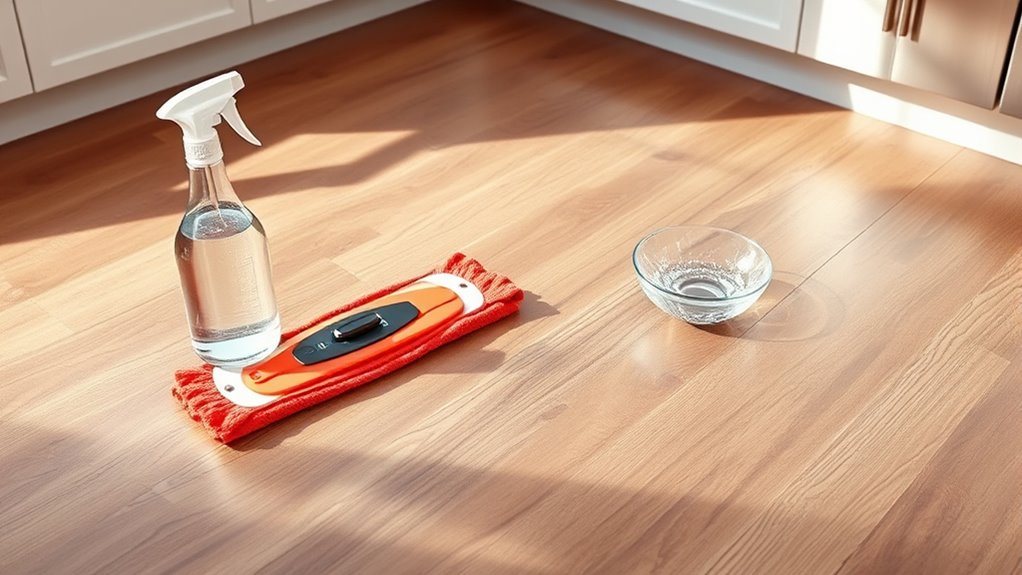
Choosing the right type of laminate floor cleaner depends on your specific needs and the condition of your floors. Understanding spray types, mop styles, and cleaning solutions helps you maintain freedom in your routine without risking damage.
- Sprays: Convenient for spot cleaning; look for non-abrasive, residue-free formulas that won’t dull your floor’s finish.
- Mops: Microfiber mops are excellent for regular dusting and light cleaning, while steam mops require caution as excessive moisture can harm laminate.
- Solutions: Concentrated liquid cleaners offer versatility; dilute as directed to avoid buildup and guarantee thorough cleaning without leaving streaks.
Selecting the right combination empowers you to keep your floors pristine while preserving their durability and appearance.
How to Properly Use Laminate Floor Cleaners for Best Results
To get the best results from your laminate floor cleaner, you’ll need to follow a few key steps that protect your flooring while maximizing cleanliness. Start by sweeping or vacuuming to remove loose dirt using effective cleaning tools like a microfiber dust mop, which prevents scratches. Next, apply your chosen laminate cleaner sparingly—never saturate the floor—to avoid moisture damage. Use a damp, not wet, microfiber mop to evenly distribute the cleaner, employing the best cleaning techniques such as gentle, circular motions. After cleaning, promptly dry the floor with a clean, dry cloth to prevent streaks and water spots. By consistently using these methods, you’ll maintain your floor’s integrity and enjoy a spotless, long-lasting finish that supports your freedom to live beautifully.
Natural and DIY Laminate Floor Cleaning Alternatives
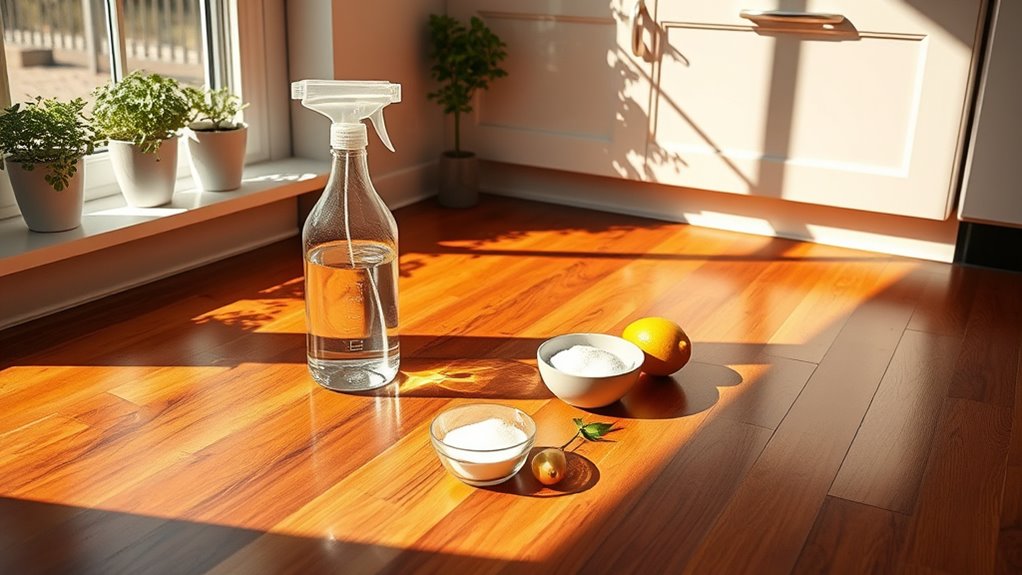
Although commercial laminate floor cleaners are effective, you might prefer natural or DIY alternatives that are gentler on your floors and free from harsh chemicals. These eco friendly options offer control over ingredients and reduce environmental impact. Here are three practical homemade solutions to try:
- Vinegar and Water Mix: Combine one cup of white vinegar with a gallon of warm water. This solution cleans effectively without leaving residue but avoid overusing to prevent dullness.
- Baking Soda Paste: Mix baking soda with water to form a paste for spot cleaning tough stains. It’s mild yet efficient.
- Castile Soap Solution: Add a few drops of liquid castile soap to a bucket of water for a gentle, natural cleaner that lifts dirt without damaging laminate.
Using these alternatives lets you maintain your floors safely and sustainably.
Common Mistakes to Avoid When Cleaning Laminate Floors
While natural and DIY cleaners offer safe options for your laminate floors, using the wrong cleaning methods can still cause damage. One of the most common cleaning mistakes is over-wetting the floor, which can lead to swelling and warping. Avoid soaking your mop or using excessive water. Improper product usage is another frequent issue—never use abrasive cleaners, wax, or oil-based products, as they can dull or damage the laminate’s protective layer. Also, steer clear of steam cleaners; the heat and moisture can cause irreversible harm. Finally, don’t neglect regular sweeping or vacuuming to remove grit that can scratch surfaces. By avoiding these pitfalls, you’ll protect your floors and maintain their appearance, giving you the freedom to enjoy a durable, beautiful laminate surface.
Tips for Maintaining Laminate Floors Between Cleanings
Even when you’re not deep cleaning, staying on top of daily care plays an essential role in preserving your laminate floors. Consistent daily maintenance prevents buildup and extends the floor’s lifespan. To keep your floors looking their best between cleanings, focus on these key practices:
- Use safe footwear: Avoid shoes with hard soles or sharp heels that can scratch the surface. Opt for soft-soled or clean indoor shoes to protect your floors.
- Sweep or vacuum regularly: Remove dust and debris daily to prevent scratches and dullness.
- Wipe up spills immediately: Laminate floors can warp if moisture sits too long, so promptly blot spills with a dry cloth.

